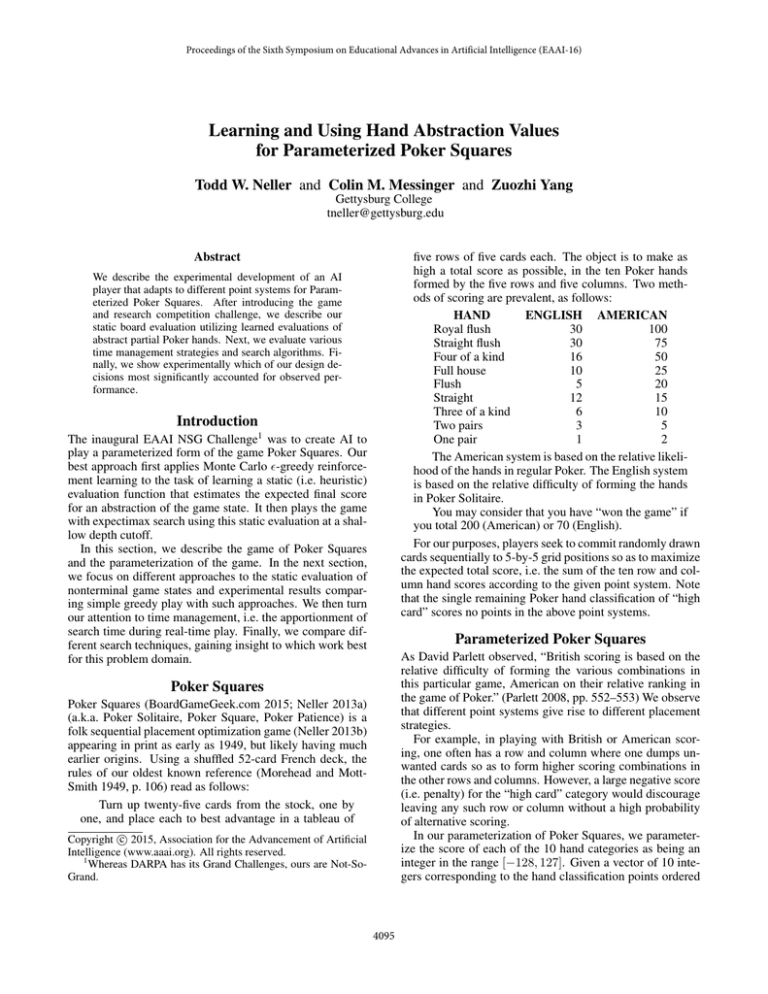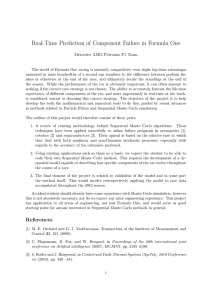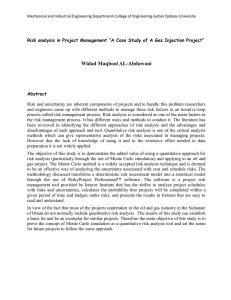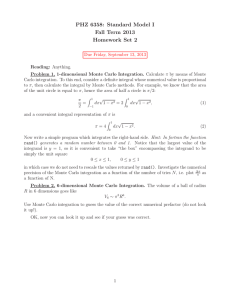
Proceedings of the Sixth Symposium on Educational Advances in Artificial Intelligence (EAAI-16)
Learning and Using Hand Abstraction Values
for Parameterized Poker Squares
Todd W. Neller and Colin M. Messinger and Zuozhi Yang
Gettysburg College
tneller@gettysburg.edu
five rows of five cards each. The object is to make as
high a total score as possible, in the ten Poker hands
formed by the five rows and five columns. Two methods of scoring are prevalent, as follows:
HAND
ENGLISH AMERICAN
Royal flush
30
100
Straight flush
30
75
Four of a kind
16
50
Full house
10
25
Flush
5
20
Straight
12
15
Three of a kind
6
10
Two pairs
3
5
One pair
1
2
The American system is based on the relative likelihood of the hands in regular Poker. The English system
is based on the relative difficulty of forming the hands
in Poker Solitaire.
You may consider that you have “won the game” if
you total 200 (American) or 70 (English).
For our purposes, players seek to commit randomly drawn
cards sequentially to 5-by-5 grid positions so as to maximize
the expected total score, i.e. the sum of the ten row and column hand scores according to the given point system. Note
that the single remaining Poker hand classification of “high
card” scores no points in the above point systems.
Abstract
We describe the experimental development of an AI
player that adapts to different point systems for Parameterized Poker Squares. After introducing the game
and research competition challenge, we describe our
static board evaluation utilizing learned evaluations of
abstract partial Poker hands. Next, we evaluate various
time management strategies and search algorithms. Finally, we show experimentally which of our design decisions most significantly accounted for observed performance.
Introduction
The inaugural EAAI NSG Challenge1 was to create AI to
play a parameterized form of the game Poker Squares. Our
best approach first applies Monte Carlo -greedy reinforcement learning to the task of learning a static (i.e. heuristic)
evaluation function that estimates the expected final score
for an abstraction of the game state. It then plays the game
with expectimax search using this static evaluation at a shallow depth cutoff.
In this section, we describe the game of Poker Squares
and the parameterization of the game. In the next section,
we focus on different approaches to the static evaluation of
nonterminal game states and experimental results comparing simple greedy play with such approaches. We then turn
our attention to time management, i.e. the apportionment of
search time during real-time play. Finally, we compare different search techniques, gaining insight to which work best
for this problem domain.
Parameterized Poker Squares
As David Parlett observed, “British scoring is based on the
relative difficulty of forming the various combinations in
this particular game, American on their relative ranking in
the game of Poker.” (Parlett 2008, pp. 552–553) We observe
that different point systems give rise to different placement
strategies.
For example, in playing with British or American scoring, one often has a row and column where one dumps unwanted cards so as to form higher scoring combinations in
the other rows and columns. However, a large negative score
(i.e. penalty) for the “high card” category would discourage
leaving any such row or column without a high probability
of alternative scoring.
In our parameterization of Poker Squares, we parameterize the score of each of the 10 hand categories as being an
integer in the range [−128, 127]. Given a vector of 10 integers corresponding to the hand classification points ordered
Poker Squares
Poker Squares (BoardGameGeek.com 2015; Neller 2013a)
(a.k.a. Poker Solitaire, Poker Square, Poker Patience) is a
folk sequential placement optimization game (Neller 2013b)
appearing in print as early as 1949, but likely having much
earlier origins. Using a shuffled 52-card French deck, the
rules of our oldest known reference (Morehead and MottSmith 1949, p. 106) read as follows:
Turn up twenty-five cards from the stock, one by
one, and place each to best advantage in a tableau of
c 2015, Association for the Advancement of Artificial
Copyright Intelligence (www.aaai.org). All rights reserved.
1
Whereas DARPA has its Grand Challenges, ours are Not-SoGrand.
4095
• Indication of whether or not a flush (“f”) is achievable
and how many undealt cards are of that suit
from high card to royal flush as in the table above, the player
then plays Poker Squares according to the given point system.
Contest point systems included American, British,
Ameritish, random, hypercorner, and single hands. Ameritish systems are randomly generated with a royal flush maximum hand score in the range of the royal flush scores of
both the British and American systems ([30, 100]). Other
hands are randomly assigned a proportion of the generated
maximum hand score that falls in the range of such proportions for both systems. Thus, Ameritish systems range from
American to British in their maximum scores and proportions of lesser scores. Random point systems are randomly
generated by the assignment of random scores in the range
[−128, 127] to each hand category. Hypercorner systems are
randomly generated by the random assignment from the set
{−1, 1} to each hand category. Single hand systems score
1 point for a single hand category and 0 points for all other
hands.
The contest goal is to design a Parameterized Poker
Squares AI player that maximizes expected score performance across the distribution of possible point systems
within real-time constraints.
• Indication of whether or not a straight (“s”) is achievable
• Indication of whether or not royal flush (“r”) is achievable
For example, “14|1(3)1(2)1(2)f(8)s” represents
a column hand abstraction after the 14th move. There is one
card in each of three ranks, two of which have two of that
rank undealt and one has three undealt. A flush is achievable
with eight cards undealt in that suit. A straight is achievable
and a royal flush is not.
During Monte Carlo reinforcement learning, such hand
abstractions are generated and stored in a hash map. Each
abstraction maps to the expected hand score and number
of occurrences of the hand. These are constantly updated
during learning. By storing the expected scores of each
row/column complete/partial hand, the hash map allows us
to sum scoring estimates for each row and column, providing a very fast estimate of the expected final score of the
game grid as a whole. Note that this naı̈vely assumes the
independence of the hand scoring estimates.
Raising Proportion of Exploration Plays
Static Evaluation
During the Monte Carlo reinforcement learning stage, we
use an -greedy policy with a geometric decay applied to
the parameter. Thus for most of time the player chooses
an action that achieves a maximal expected score, but also
makes random plays with probability .
In our initial application of -greedy play, = 0.1 with
geometric -decay δ = 0.999975 per simulated game iteration. However, we empirically observed that if we significantly raise the initial value of to 0.5, increasing initial
exploration, the player has a better performance.
In addition, the time cost for random play is much less
than greedy play, so increasing the proportion of random
plays increases the number of overall learning iterations per
unit time. Empirically, this relatively higher will not only
raise the number of exploration plays but also will be able
to leave sufficient time for exploitation plays. Note that sufficient exploitation play is necessary for long term planning
(e.g. royal flush, straight).
For each point system tested in contest evaluation, each
AI player is given the point system and 5 minutes to perform preprocessing before beginning game play. For each
game, each player is given 30 seconds of total time for play
decision-making. One hundred games are then played with
the given point system, and players are rewarded a tournament score on a linear scale from 0 to 1 from the minimum
to maximum total game points, respectively. Thus the 5 minutes should be well-utilized to create an evaluation function
for the game state that is able to efficiently provide a good
approximation of the expected score of any game state for
any point system.
While the total state space is too large to evaluate beforehand, we take the computer Poker research approach of abstracting the state space and then applying on-policy Monte
Carlo reinforcement learning in order to simultaneously improve estimates of the abstracted game and improve play
policy that guides our Monte Carlo simulations.
Considering Frequency of Partial Hand Sizes
Abstracting Independent Hands
We observed our player’s behavior and found that it tended
to spread cards evenly among rows and columns in the early
and middle stages of the game. The reason for this behavior
is that the player is making greedy plays that maximize expected score gain. In a pre-evaluation between NARL and
another player developed earlier that performed better under
the single-hand Two Pairs point system, we observed that
with same card dealt, NARL tended to set up one pair evenly
among rows and columns according to the assumption of
hand independence, while the comparison player appeared
to gain an advantage by preferring to focus on developing a
row/column with a pair and two single cards early.
Based on this observation, we added the current distribution of hand sizes to the abstraction. The number of cards
Our Naı̈ve Abstract Reinforcement Learning (NARL) player
abstracts the state of each independent row/column and
learns the expected value of these abstractions through
Monte Carlo -greedy reinforcement learning. Each hand
abstraction string consists of several features which we considered significant:
• Number of cards played in the game so far
• Indication of row (“-”) or column (“|”)
• Descending-sorted non-zero rank counts and how many
cards are yet undealt in each of those ranks appended to
each parenthetically
4096
Scaled Scores by Point Systems and Evaluators
1
0.9
0.8
0.7
0.6
0.5
0.4
0.3
0.2
0.1
NARL
ou
se
H
Fu
ll
Fl
us
h
St
ra
ig
ht
in
d
4
of
a
K
of
a
3
NARL + eps = .5
K
in
d
r
Pa
i
o
Tw
O
ne
Pa
ir
d
Ca
r
ig
h
H
Br
iti
sh
A
m
er
ic
an
co
rn
er
yp
er
H
Ra
nd
om
A
m
er
iti
sh
0
NARL + eps = .5 + Hand Size
Figure 1: Comparison of learning evaluation performance. NARL with 0 = 0.5 performed best for most point systems.
Real-Time Search: Time Management and
Search Algorithm
played in each row and column are tallied, and we summarize the distribution in a hand size frequency vector represented as a string. For instance, the string “721000” represents a grid hand size distribution after the 2nd move. (The
number of cards dealt can be inferred from the abstraction.)
The zero-based index of the string corresponds to hand size
in a row/column. Thus, “721000” indicates that there are
seven empty hands, two with one card, one with two cards,
and none with more than two.
Paths through the Poker Squares game tree alternate between
chance and choice nodes. Given unbounded computational
time, one could perform a depth-first expectimax evaluation
of the game-tree in order to inform perfect play decisions.
However, the size of the game-tree prohibits such an approach.
There are two top level design decisions in our approach.
First, we choose a time management policy that focuses
search effort during the points of the game where it is of
greatest benefit to play. Next, we choose a search algorithm
that best utilizes our approximate static evaluation in order
to discern nuances lost in our abstraction and more closely
approximate optimal play.
The previous grid hand abstraction is trained together with
hand size abstraction to learn the difference between the final score and expected score at each of the 25 states across
the game. In practice, we find that adding this abstraction
feature generally improves performance for some simpler
point systems
Time Management
The time given to make play decisions should be distributed
such that score is maximized. To manage time more efficiently, all time management policies give no consideration
to the first and final plays, as these are inconsequential and
forced, respectively. Two time-management system we used
to distribute allotted time across turns were:
Experiments and Data
We experimented with 3 players, all of which used -decay
δ = 0.999975. The first used an initial epsilon 0 = 0.1,
whereas the second and third used 0 = 0.5. Only the third
player incorporated the hand size frequency abstraction feature.
• Uniform time management (UTM) divides the given time
evenly between all plays that were to be considered.
• Gaussian time management, GTM, distributes time according to a Gaussian curve as in the “MID” timemanagement policy of (Baier and Winands 2012), where
parameters specify the mean b and standard deviation c,
so that b specifies where in the game play time is most
concentrated and c specifies how concentrated play time
is at the mean.
For each random point system (the Ameritish point system, Random point system, Hypercorner point system) we
generated a sample of 500 systems and measured the average greedy-play performance of 2000 games for each player
and system. For fixed point systems, we collected average
performance of 2000 games for each player and system. For
each point system, performance was scaled between 0 and 1
as with the previously described tournament scoring.
In our next experiment, we applied each time allocation policy to a simple player that selected the play with
the best scoring average from uniformly-distributed Monte
Carlo simulation with greedy score-maximizing play to a
Results are given in Figure 1. NARL with 0 = 0.5 dominated all but three point systems where the addition of the
hand size abstraction proved best.
4097
Time Management Policies
1.2
1
0.8
0.6
0.4
0.2
GTM, b=8, c=10
GTM, b=8, c=12
d
aK
ou
GTM, b=12, c=12
4
of
H
ll
Fu
GTM, b=12, c=10
in
se
us
h
Fl
St
ra
ig
ht
d
in
aK
of
3
A
m
er
iti
sh
Br
iti
sh
A
m
er
ic
an
0
UTM
Figure 2: Comparison of performance under different time management policies. UTM was the best time management policy
overall.
play decisions based on the values of the states as determined by the static evaluation and the search algorithm. Several search algorithms were implemented, including Uniform Greedy Monte Carlo (GMC), UCB1 Greedy Monte
Carlo (UCB), and depth-limited expectimax.
Total Normalized Chart Scores
8.00
7.00
6.00
5.00
4.00
3.00
Uniform Greedy Monte Carlo Greedy Monte Carlo simulates play from the current state up to a given depth limit
5 ahead of each possible move, and then computes a static
evaluation on the resulting state. Whereas the first action
is taken a uniform number of times, following moves are
chosen at random from among greedy plays that yield the
maximum score for the next state. The move which returns
the greatest average score at the depth limit or terminal state
is then selected.
2.00
1.00
0.00
GMC
UCB
NARL
Expectimax
.5 eps.
CSE
ASE
Hand Size
Figure 3: Comparison of performance of combinations of
search algorithms and evaluators. Expectimax (depth 2)
combined with the NARL evaluator (0 = 0.5) performed
best.
UCB1 Greedy Monte Carlo UCB1 (Auer, Cesa-Bianchi,
and Fischer 2002) looks to balance exploration of the game
tree with exploitation of the best scoring opportunities. Implementation was much like Greedy Monte Carlo, except
that the root actions were chosen with the UCB1 algorithm.
The algorithm finds the average score
resulting from a move
in simulation, then adds the term 2ln(n)
nj , where n is the
total number of simulations and nj is the number of simulations of a move j. In our version, the added term is multiplied by 20 to promote more frequent early exploration.
depth limit of 5. GTM was tested with multiple players,
with each player given different parameters for the curve’s
mean and standard deviation. Each player was tested for 100
games per point system. After all players had been tested
for one system, they were assigned tournament points in the
range from 0 to 1 as previously described. Results are shown
in Figure 2.
UTM was the best time management policy overall. With
the exception of the single-hand 3 of a kind and flush point
systems, UTM always outperformed every other time management policy tested. For the single-hand flush system,
UTM almost always outperformed, and for 3 of a kind, UTM
was outperformed by GTM with b = 8, c = 10.
Expectimax Expectimax is the single-player specialization of expectiminimax (Russell and Norvig 2010, p. 178).
Given our real-time constraints, expectimax could only be
performed to a shallow depth limit of 2. Two variants were
created in order to solve this problem: chance-sampled expectimax (CSE) takes a random sample of chance events
and averages them, while action-sampled expectimax (ASE)
uses the static evaluation to approximate values for each
choice node and then performs full simulations of the best.
Search Algorithms
In order to make play decisions, the player uses a search algorithm to examine the branches of the game tree and determine the values of various moves. The player then makes
4098
Component Comparison
Normalized Scores
1.2
1
0.8
0.6
0.4
0.2
0
American
British
Ameritish
3 of a Kind
Expectimax, NARL .5 eps.
Straight
Expectimax, simple eval.
Flush
Full House
4 of a Kind
GMC, NARL .5 eps.
Figure 4: Comparison of individual component significance with various point systems. The learned static evaluation component was most significant.
of hands under the single-hand 3-of-a-kind point system,
and performing worst at all other games. It is interesting
to note that complete expectimax search to depth 2 only
slightly outperformed greedy Monte Carlo to depth 5 for
most point systems.
Coupling this with the observation that depth 2 expectimax only used about 2.8 seconds out of its allotted 30 seconds of play time per game, it is likely that our search time
would be better utilized in future work through either a hybrid of the two approaches, e.g. greedy Monte Carlo estimation at expectimax depth 2, or through the application of a
Monte Carlo Tree Search algorithm (Browne et al. 2012), an
approach seeing much success across many similar games.
Our action-sampled expectimax also made use of chancesampling. These algorithms made no use of time management.
Experimental Comparison To compare the relative performance of 5 different search methods (Greedy Monte
Carlo, UCB1, Expectimax (depth 2), Chance Sampled Expectimax (CSE; depth 2, 38 chance sample maximum), and
Action Sampled Expectimax (ASE; depth 2, 40 chance samples maximum, 20 action samples maximum)) combined
with the 3 different NARL learning systems we compared
before, we ran a tournament with 8 scoring systems (Figure 3). The Ameritish system was generated with contest
software using seed 21347. One hundred games were run
per player and point system pair. UTM was used for all
players that used time management. Total scores listed are
the sum of the tournament scores for each of the 8 point systems.
In these experiments, expectimax (depth 2) combined
with the NARL evaluator (0 = 0.5) performed best.
Conclusion
From our experimentation with reinforcement learning of
a static state evaluator based on hand abstractions, various
time management techniques for real-time play, and various
search techniques, we found our static state evaluator work
to be the most significant source of performance improvement.
This has two possible implications: Either (1) our easiest
future performance gains could come from further improvement of the static evaluator, or (2) our greatest untapped potential is in the area of search algorithm design. Given that
we fully utilize our static evaluator learning time and use
only 9.4% of allotted play decision time, we conjecture that
the greatest improvements to be realized will be in improved
search algorithm design.
Significance of Each Design Component
After determining that expectimax search (depth 2) with
NARL evaluation (0 = 0.5) was our best combination, a
final test was performed to determine how significant each
of the player’s components was. Two additional players
were constructed with components omitted. The first used
depth 2 expectimax, but with a simple static current-score
evaluation. The second used greedy Monte Carlo play combined with the NARL (0 = 0.5) evaluation. Time management was not tested as a factor, as the best search algorithm did not use time management. However, the greedy
Monte Carlo player did utilize UTM for its necessary time
management. For each point system and player pair, 100
games were played and scoring was performed by tournament rules. Results can be seen in Figure 4.
Reverting from Naı̈ve Abstract Reinforcement Learning
(NARL) to a simple scoring of the current grid caused the
most significant decline in performance, winning a fraction
References
Auer, P.; Cesa-Bianchi, N.; and Fischer, P. 2002. Finitetime analysis of the multiarmed bandit problem. Machine
Learning 47(2-3):235–256.
Baier, H., and Winands, M. 2012. Time management
for monte-carlo tree search in go. In van den Herik, H.,
and Plaat, A., eds., Advances in Computer Games, vol-
4099
ume 7168 of Lecture Notes in Computer Science. Springer
Berlin Heidelberg. 39–51.
BoardGameGeek.com. 2015. Poker Squares. http://www.
boardgamegeek.com/boardgame/41215/poker-squares.
Browne, C.; Powley, E.; Whitehouse, D.; Lucas, S.; Cowling, P. I.; Rohlfshagen, P.; Tavener, S.; Perez, D.; Samothrakis, S.; and Colton, S. 2012. A survey of Monte
Carlo tree search methods. IEEE Trans. on Computational Intell. and AI in Games 4(1). also available at
http://www.cameronius.com/cv/mcts-survey-master.pdf.
Morehead, A. H., and Mott-Smith, G. 1949. The Complete
Book of Solitaire & Patience Games. Grosset & Dunlap,
1st edition.
Neller, T. 2013a. Poker Squares. http://cs.gettysburg.edu/
∼tneller/games/pokersquares.
Neller, T. 2013b. Sequential Placement Optimization
Games. http://www.boardgamegeek.com/geeklist/152237/
sequential-placement-optimization-games.
Parlett, D. 2008. The Penguin Book of Card Games. Penguin Books, updated edition.
Russell, S., and Norvig, P. 2010. Artificial Intelligence: a
modern approach. Upper Saddle River, NJ, USA: Prentice
Hall, 3 edition.
4100







